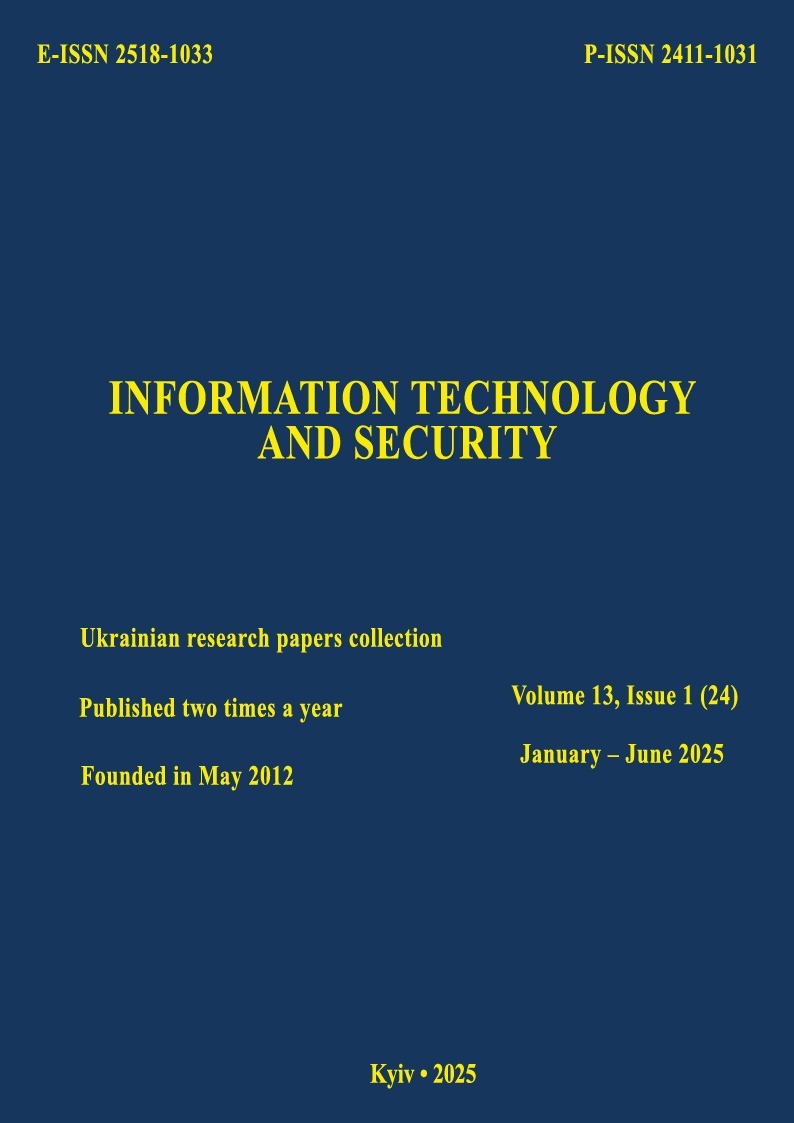Model of knowledge presentation in mobile radio media decision support systems
DOI:
https://doi.org/10.20535/2411-1031.2025.13.1.328976Keywords:
mobile radio communication, radio communication tools, decision support, knowledge representation, neural networksAbstract
The article proposes a model of knowledge representation in decision support systems for mobile radio communication. In the course of the work, the process of construction and the process of functioning of modern mobile radio communications were considered, the essence of decision support systems and the main classes of decision support systems were revealed. An analysis of the latest research on methods of presenting knowledge, the functioning of management systems, decision support systems, and mobile radio communication tools was carried out. The essence of the concept of knowledge and the system of presenting knowledge were also revealed. The levels of knowledge representation are considered, a generalized classification of types of knowledge representation methods is indicated. It was indicated that the main issue in building knowledge representation systems is the choice of the form of knowledge representation. Also, the knowledge representation model should characterize the tasks being solved, and should be built consistently on the basis of appropriate templates, properties, program characteristics, interaction language, etc. Also, the work puts forward requirements for the development of a decision support model, taking into account the need for its use in mobile radio communication tools, and suggests a method of modification and development of such a model. The essence of the model consists in the modification of the decision-making support process, a method of adapting the production and neuro-fuzzy way of presenting knowledge, taking into account the conditions of operation of mobile radio communication tools to improve the effectiveness of decision-making support. The proposed model, thanks to the correct formulation of the research task and the use of a proven mathematical apparatus, satisfies the requirements for the development of such a model and allows to increase the speed and accuracy of decision support. As a result, the goal of developing a knowledge representation model in decisionmaking support systems of mobile radio communication tools to systematize the management process and improve the performance indicators of the decision-making support system based on the use of proven mathematical devices was achieved.
References
S. Salnyk “Methodology of intelligent control of the interaction of control system elements in mobile radio networks”, Information Technology and Security, vol. 10, iss. 2, рр. 241-249, 2022, doi: https://doi.org/10.20535/2411-1031.2022.10.2.270584.
Decision support system. [Online]. Available: https://wiki.loginom.ru/articles/decisionsupport-system.html. Accessed on: Oct. 14, 2024.
O. Lavrut, T. Lavrut, O. Klymovych, and Y. Zdorenko, “Latest technologies and means of communication in the Armed Forces of Ukraine: the path of transformation and development prospects”, Scien. & Tech. of the Air Force of the AF of Ukraine, no. 1 (34), pp. 91-101, 2019, doi: https://doi.org/10.30748/nitps.2019.34.13.
О. Velichko, B. Demidov, M. Borysenko, V. Kovalenko, and S. Shcherbinin, “Methodological and system-conceptual provisions and aspects of building promising automated control systems”, Col. of scien. works of the Kharkiv NU of the AF, no. 4(74), pp. 87-95, 2022, doi: https://doi.org/10.30748/zhups.2022.74.13.
O. Turinsky, M. Pavlenko, G. Pevtsov, and S. Osievsky, “A method for increasing the efficiency of the functioning of a human-machine system by improving the quality of software for decision support systems”, Scien. & Tech. of the Air Force of the AF of Ukraine, no. 4 (41), pp. 125-132, 2020, doi: https://doi.org/10.30748/nitps.2020.41.15.
T. Bilova, V. Dyomina, S. Mar’in, and I. Pobyzhenko, “Using fuzzy logic to represent knowledge by temporal precedents under conditions of uncertainty”, Information Processing Systems, no.1 (172), pp. 7-12, 2023, doi: https://doi.org/10.30748/soi.2023.172.01.
T. Zheldak, L. Koryashkina, and S. Us, Fuzzy sets in control and decision-making systems: tutorial. Dnipro, Ukraine: NTU “Dniprovska Polytechnica”, 2020.
Intellectual methods in management. [Online]. Available: https://www.dstu.dp.ua/Portal/Data/3/19/3-19-kl19.pdf. Accessed on: Oct. 14, 2024.
Knowledge representation models. [Online]. Available: https://studfile.net/preview/4001647/. Accessed on: Oct. 14, 2024.
Knowledge representation models: types, classification and application methods. [Online]. Available: https://presa.com.ua/navchannia/modeli-podannya-znan-vidi-klasifikatsiya-tametodi-zastosuvannya.html. Accessed on: Oct. 14, 2024.
V. Meitus, “Knowledge Representation in Intelligent Systems”, Scientific Notes of the National University “Kyiv-Mohyla Academy”, Computer Science, vol. 177, pp. 4-9, 2015. [Online]. Available: https://ezp.ukma.edu.ua/bitstreams/da3af8be-9800-4300-ba0c-9fd7eabb3397/download. Accessed on: Oct. 14, 2024.
P. Fedoruk, and S. Maslovsky, “Knowledge Representation Model in the Adaptive Distance Learning and Knowledge Control System EduPRO”, Artificial Intelligence, no. 3, pp. 463-472, 2011. [Online]. Available: https://jai.in.ua/index.php/архів?paper_num=1201. Accessed on: Dec. 12, 2024.
Lecture 5. Fuzzy model of knowledge representation. [Online]. Available: https://studfile.net/preview/14517611/. Accessed on: Jan. 17, 2025.
Neural fuzzy networks. Fuzzy logic in MatLab. [Online]. Available: https://studfile.net/preview/5474324/page:3/. Accessed on: Feb. 23, 2024.
Downloads
Published
How to Cite
Issue
Section
License
Copyright (c) 2025 Collection "Information Technology and Security"

This work is licensed under a Creative Commons Attribution 4.0 International License.
The authors that are published in this collection, agree to the following terms:
- The authors reserve the right to authorship of their work and pass the collection right of first publication this work is licensed under the Creative Commons Attribution License, which allows others to freely distribute the published work with the obligatory reference to the authors of the original work and the first publication of the work in this collection.
- The authors have the right to conclude an agreement on exclusive distribution of the work in the form in which it was published this anthology (for example, to place the work in a digital repository institution or to publish in the structure of the monograph), provided that references to the first publication of the work in this collection.
- Policy of the journal allows and encourages the placement of authors on the Internet (for example, in storage facilities or on personal web sites) the manuscript of the work, prior to the submission of the manuscript to the editor, and during its editorial processing, as it contributes to productive scientific discussion and positive effect on the efficiency and dynamics of citations of published work (see The Effect of Open Access).

